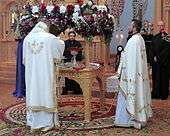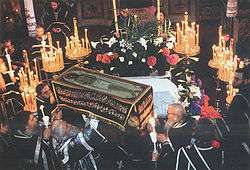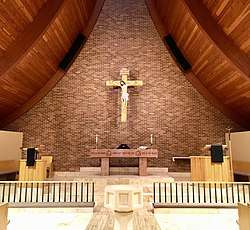Holy Saturday
Holy Saturday (Latin: Sabbatum Sanctum), the Saturday of Holy Week, also known as Holy and Great Saturday, the Great Sabbath, Black Saturday, Hallelujah Saturday (in Portugal and Brazil), Glorious Saturday (in the Philippines) or Easter Eve,[1] and called "Joyous Saturday" or "the Saturday of Light" among Coptic Christians, is the day after Good Friday. It is the day before Easter and the last day of Holy Week in which Christians prepare for Easter. It commemorates the day that Jesus' body lay in the tomb and the Harrowing of Hell.
| Holy Saturday | |
|---|---|
 Statue of Jesus lying in the tomb by Gregorio Fernández. (Monastery of San Joaquín y Santa Ana, Valladolid) | |
| Official name | Holy Saturday |
| Also called | Easter Eve, Black Saturday |
| Observed by | Christians |
| Type | Religious |
| Significance | Marks the day Jesus' body lay in the tomb and the Harrowing of Hell |
| Date | Day before Easter |
| 2019 date |
|
| 2020 date |
|
| 2021 date |
|
| 2022 date |
|
| Frequency | annual |
| Related to | Easter |
Terminology
Eastern traditions
In Eastern Orthodoxy this day, known as Holy and Great Saturday, is also called The Great Sabbath since it is on this day that Christ "rested" physically in the tomb. But it is also believed that it was on this day he performed in spirit the Harrowing of Hell and raised up to Paradise, having liberated those who had been held captive. In the Coptic, Ethiopian and Eritrean Orthodox Churches, this day is known as Joyous Saturday, otherwise known as the night of light and joy.[2]
Western traditions
In Western traditions, the day is usually called Holy Saturday, although in the Moravian Church, the day is referred to as the Great Sabbath and in the Anglican Communion, the Book of Common Prayer refers to the day as Easter Even.[3][4] Although the term Easter Saturday is usually applied to the Saturday in Easter week,[5][6] in English-speaking countries it is sometimes applied to Holy Saturday, including in legislation in the Australian states of New South Wales and Queensland,[7] and by Australian government agencies.[8] In the Catholic tradition, the Blessed Virgin Mary as Our Lady of Sorrows is on this day assigned the title Our Lady of Solitude, referring to her solace and grief at the death of her son Jesus. However, nowhere in Catholic liturgical documents is this day referred to as the feast of Our Lady of Solitude.
Religious and cultural practices
Eastern traditions
Matins of Holy and Great Saturday (in parishes usually held on Friday evening)[9][10] takes the form of a funeral service for Christ. The entire service takes place around the Epitaphios, an icon in the form of a cloth embroidered with the image of Christ prepared for burial. The first part of the service consists of chanting Psalm 118, as usual at both Saturday matins and at funerals, but interspersed with hymns (enkomia or lamentations) between the verses. The predominant theme of the service is not so much one of mourning, but of watchful expectation:[11]
Today Thou dost keep holy the seventh day,
Which Thou has blessed of old by resting from Thy works.
Thou bringest all things into being and Thou makest all things new,
Observing the Sabbath rest, my Saviour, and restoring strength.[12]
Near the end of matins, at the end of the Great Doxology, the Epitaphios is taken up and carried in procession around the outside of the church, while the Trisagion is sung, as is done when carrying the body to the cemetery in an Orthodox burial.

On Saturday, a vesperal Divine Liturgy of Saint Basil the Great is celebrated, called the First Resurrection Service (Greek: Ἡ Πρώτη Ἀνάστασις), named so because chronologically it was composed earlier than the Paschal Canon by St John Damascene, rather than because it occurs earlier liturgically.[13] This is the longest Divine Liturgy of the entire year and the latest. After the Little Entrance there are 15 Old Testament readings that recall the history of salvation. In the Russian tradition, just before the Gospel reading (Matthew 28:1–20) the hangings, altar cloths and vestments are changed from dark to bright and the deacon performs a censing of the church. In the Greek tradition, the clergy strew laurel leaves and flower petals all over the church to symbolize the shattered gates and broken chains of hell and Jesus' victory over death. While the liturgical atmosphere changes from sorrow to joy at this service, the faithful continue to fast and the Paschal greeting, "Christ is risen!", is not exchanged until after midnight during the Paschal Vigil since this service represents the proclamation of Jesus' victory over death to those in Hades, but the Resurrection has not yet been announced to those on earth which takes place during the Paschal Vigil.

Great Lent was originally the period of catechesis for new converts in order to prepare them for baptism and chrismation and when there are converts received, that occurs during the Old testament readings during the vesperal divine liturgy. Before the midnight service, the faithful gather in church for the reading of the Acts of the Apostles in its entirety. Preceding midnight the Paschal Vigil begins with the Midnight Office, during which the Canon of Holy Saturday is repeated, toward the end of which the epitaphios is removed from the center of the church and placed on the altar table where it remains until the Ascension. Then, all of the candles and lights in the church are extinguished, and all wait in darkness and silence for the proclamation of the Resurrection of Christ.
Prior to the composition of the current Paschal Vigil of St. John of Damascus,[14] this day's vesperal liturgy was the main Easter celebration.
Notes
- 1.^ In Greek practice, this was done at Matins the night before (i.e. Matins of Holy Saturday).
Western traditions
In the Roman Catholic Church, the chancel remains stripped completely bare (following the Mass on Maundy Thursday). All Masses are severely limited; no Mass at all appears in the normal liturgy for this day, although Mass can be said on Good Friday and on Holy Saturday for an extremely grave or solemn situation with a dispensation from the Vatican or the local bishop. The celebration of the Sacraments is extremely limited: Holy Communion is given only as Viaticum to the dying; while Penance, and Anointing of the Sick may be administered because they, like Viaticum, are helpful to ensuring salvation for the dying. The day is the second day of the Paschal fast as outlined in Sacrosanctum Concilium, Article 110, although fasting may not be as stringent as on Good Friday.[15]
Many of the churches of the Anglican Communion as well as Lutheran, Methodist, and some other Churches observe most of the same customs of the Catholic Church; however, their altars may be covered in black instead of being stripped. In some Anglican churches, including the Protestant Episcopal Church in the United States of America, provision is made for a simple Liturgy of the Word on this day, with readings commemorating the burial of Christ. Daily Offices are still observed. In the Moravian Church, the day is known as Great Sabbath.[3] The Anglican Book of Common Prayer uses Easter Even to designate the day.

In the Roman Catholic, Lutheran, Anglican and Methodist traditions, Holy Saturday lasts until nightfall, after which the Easter Vigil is celebrated, marking the official start of the Easter season.[16] The rubrics[17] state that the Easter Vigil must take place in the night; it must begin after nightfall and end before dawn. The service may start with a fire and the lighting of the new Paschal candle. In Roman Catholic and some Anglican observance, the Mass is the first Mass since that of Maundy Thursday, and during it, the "Gloria" — which has been absent during Lent — is used as the statues and icons, covered with purple veils during Passiontide, are dramatically unveiled. Some Anglican churches prefer to celebrate Easter and the lighting of the new Paschal candle at dawn on Easter Day. Baptisms may take place in this service and Baptismal vows are often renewed.
In the predominantly Roman Catholic Philippines, the day is legally and colloquially known in English as Black Saturday, given the colour's role in mourning. Traditional taboos from the previous day are carried over and are sometimes broken; swimming is allowed in the afternoon. Most commercial establishments resume operations, with smaller enterprises remaining closed until Easter. Television and radio stations broadcast on shorter hours with special programming or remain off-air. After the liturgical changes of the Second Vatican Council, the term Sábado de Gloria (Spanish for Gloria Saturday) became widely used, referring to the return of chanting the Gloria in Excelsis Deo during the Easter Vigil. In predominantly Roman Catholic Poland, Święconka (Polish pronunciation: [ɕvʲɛnˈtsɔnka]), meaning "the blessing of the Easter baskets", on Holy Saturday, is one of the most enduring and beloved traditions.
Notes
- "Public Report on Audience Complaints and Comments, April–June 2006" (PDF). Australian Broadcasting Corporation. Retrieved 4 May 2013.
- Michael Keene (1995). The Christian Experience. Nelson Thornes. p. 112. ISBN 978-0-7487-2188-7.
- Walker, Donna (19 April 2014). "Moravians celebrate the Great Sabbath". LancasterOnline. Retrieved 11 April 2020.
- https://www.churchofengland.org/prayer-worship/worship/book-of-common-prayer/collects-epistles-and-gospels/easter-even.aspx
- "Public Report on Audience Complaints and Comments, April–June 2006" (PDF). Australian Broadcasting Corporation. Retrieved 25 April 2011.
- "Confusing Easter Dates". The Liturgical Commission of the Roman Catholic Archdiocese of Brisbane. Archived from the original on 19 January 2012.
- Public Holidays Act 2010 (NSW) s 4, Industrial Relations Act 2016 (Qld) Schedule 5, definition "public holiday".
- Australian Government, Public holidays Archived 4 January 2015 at the Wayback Machine
- "The Lamentations Service for Holy Saturday Matins". OrthoChristian.Com. Retrieved 28 April 2019.
- "Protopresbyter Alexander Schmemann: This is the Blessed Sabbath". schmemann.org. Retrieved 28 April 2019.
- Kallistos (Ware), Bishop; Mary, Mother (1977). The Lenten Triodion. South Canaan PA: St. Tikhon's Seminary Press (published 2002). p. 63. ISBN 1-878997-51-3. OCLC 189871515.
- Matins Canon of Holy and Great Saturday, Ode 4
- Parry, Ken; Melling, David J.; Brady, Dimitri; Griffith, Sidney H.; Healey, John F. (1999). The Blackwell Dictionary of Eastern Christianity. Oxford: Blackwell. pp. 390–391. ISBN 0-631-23203-6.
- Parry et al. (1999), p. 390
- https://www.vatican.va/archive/hist_councils/ii_vatican_council/documents/vat-ii_const_19631204_sacrosanctum-concilium_en.html
- "Liturgical Seasons of the Church Year". St John Lutheran Church. Retrieved 11 April 2020.
Holy Saturday is a day of waiting and yearning until evening when the Easter Vigil is celebrated. A service of light, readings, Holy Baptism and Holy Communion. It is the first Easter liturgy celebrated in the darkness of Easter Eve.
- Roman Missal, 3rd Edition.
References
- Parry, Ken; David Melling, eds. (1999). The Blackwell Dictionary of Eastern Christianity. Malden, MA.: Blackwell Publishing. ISBN 0-631-23203-6. OCLC 156905118.



